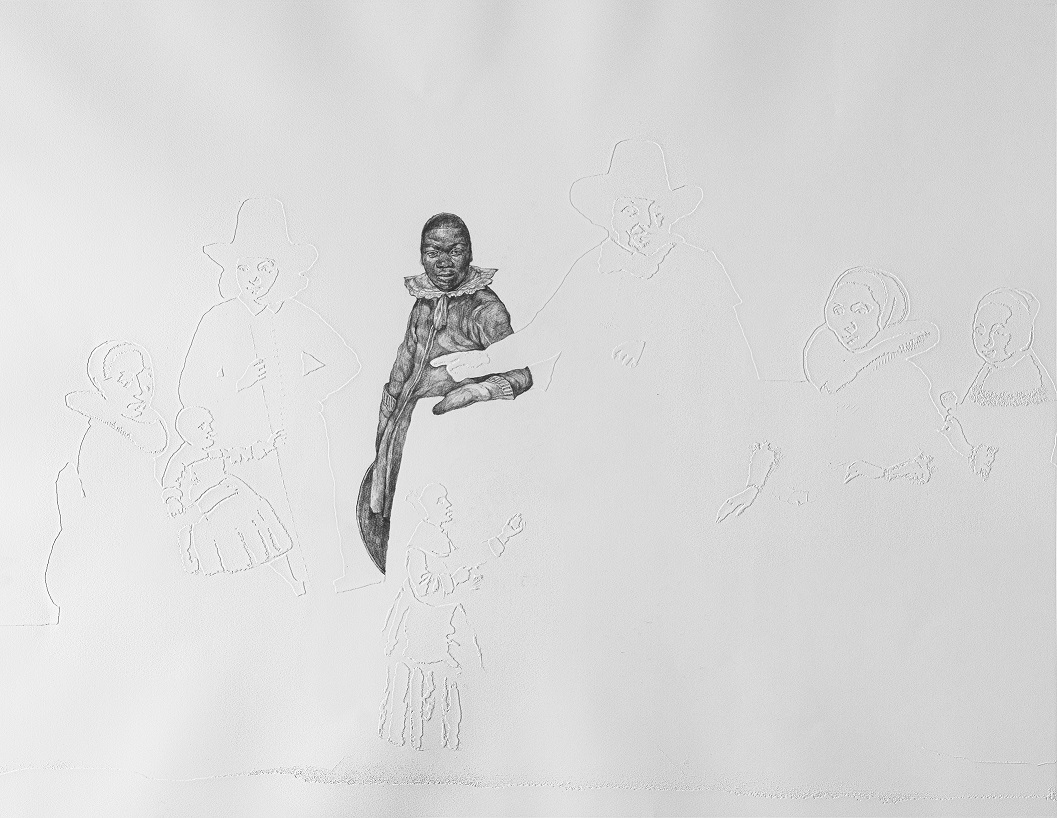
REVIEW: BLACK ATLANTIC: POWER, PEOPLE, RESISTANCE
A local historian’s review of the Fitzwilliam Museum’s seminal exhibition.
ReviewsDr Carol Brown-Leonardi, a local historian and founder and chair of the African Caribbean Research Group, shares her review of the Fitzwilliam Museum’s Black Atlantic: Power, People, Resistance exhibition, which explored Cambridge’s role in the transatlantic slave trade.
Image: ‘Vanishing Point 29 (Duyster)’, Barbara Walker. 2021. Courtesy the artist and Cristea Roberts Gallery, London. © Barbara Walker, 2025.
Like many elite institutions in Britain, the Fitzwilliam Museum is a recipient of substantial endowments linked to the transatlantic slave trade.
The ‘Black Atlantic: Power, People, Resistance‘ exhibition is a bold effort by the Fitzwilliam Museum curators to examine Britain’s role in slavery. Reflections on the legacies of enslavement are revealed in the abhorrent reality that the Fitzwilliam family’s wealth was derived from slavery. The portraits, sculptures, maps, ceramics, and artefacts silently conveyed notions of white supremacy and oppression – an encounter with the harsh realities of empire.
Like many elite institutions in Britain, the Fitzwilliam Museum is a recipient of substantial endowments linked to the transatlantic slave trade. The entrance to the exhibition featured a portrait of the young Fitzwilliam in his Cambridge University gown. Beside him, a portrait of an elegantly dressed Black man – unidentified, yet striking. This mystery was the first for viewers to grapple with: an unknown image, possibly of Olaudah Equiano, Ignatius Sancho, or an anonymous man.
Whilst Equiano and Sancho are recognised as notable 18th-century authors and abolitionists, the contrast between the documented and undocumented histories of Fitzwilliam, Equiano, and Sancho defined an era marked by erasure and loss. This poignant association echoed the historical fate of the 12.5 million unidentified human beings who lost their lives to the heinous system of slavery. In this sense, the curators’ shrewd approach – eschewing familiar methods of presenting 18th-century history – reminds us that there is power in silenced voices.
This mystery was the first for viewers to grapple with: an unknown image, possibly of Olaudah Equiano, Ignatius Sancho, or an anonymous man.
Actor Jyuddah Jaymes’s narration of Equiano’s testimony about the Middle Passage was a moving representation of first-hand trauma, pain, despair, and brutality – a heartbreaking, disturbing encounter with past realities. Listening to these words burned the soul. Only a few steps away stood stunning examples of craftsmanship created by African and Indigenous peoples – civilisations that would be dimmed by slavery. West African hand-crafted gold weights, rare Indigenous tools, and ceremonial stone objects (pre-1500) provided insight into another world.
Bridging ancient and 18th-century capitalist eras, the African Wari board [or Oware, a traditional African board game] and stones were gently tucked away, having travelled alongside the African diaspora to the New World throughout the period of enslavement. Surviving all European attempts to erase African cultures among the enslaved, the Wari board game stands as a symbol of resilience and cultural preservation against all odds.
The exhibition also explored 17th-century perceptions of the enslaved and slavery’s association with Blackness. Keith Piper’s ‘Coloured Codex (Enlightened Edition)’. (2023) serves as a reminder of the challenges faced by people of mixed heritage born to white fathers. Some people of colour – often wealthier than their white counterparts – were nonetheless bound by a single drop of melanin that determined their lives under colonial, apartheid-style laws. These racial categories, designed to justify enslavement and uphold racial hierarchies, continue to shape our contemporary society.
No longer merely a centrepiece that signified the Europeans’ wealth, the Black man now stands his ground in his own space.
‘Vanishing Point 29 (Duyster)’ by Barbara Walker (2021) challenges ideas around the invisibility and dehumanisation of Black people. Based on a 17th-century Dutch painting depicting a Black man seated at the centre of a wealthy white family, Walker reworks the historical piece into a powerful artwork. She outlines the white figures while drawing the African man in graphite, emphasising his Blackness at the focal point – creating a powerful moment of reflection. No longer merely a centrepiece that signified the Europeans’ wealth, the Black man now stands his ground in his own space.
Jamaican artist Jacqueline Bishop’s exhibit, ‘History at the Dinner Table’ (2021) pays homage to the suffering of enslaved women. Her work lends dignity to the familiar horrific illustrations found in Captain John Stedman’s graphic book, ‘Narrative of a Five Years’ Expedition Against the Revolted Negroes of Surinam in Guiana’ (1796). For me, her use of fine bone china plates served as a metaphor for Caribbean island encounters. Caribbean flora – exquisite, enchanting, and vibrant – at first appears a breathtaking sight for passersby. However, a longer gaze reveals the underlying human suffering: a dark and cruel history rooted in slavery. These revelations make it difficult for observers to fix their gaze without experiencing discomfort and confronting painful truths.
To counter this image of enslaved Black women, I reminded myself of Jamaica’s national hero, Nanny of the Maroons, and other enslaved women who embodied strength and wisdom.
The exhibit created space for discussion around the slave trade’s destruction of Black women’s autonomy through despicable practices fuelled by hate, racism, violence, and profit. To counter this image of enslaved Black women, I reminded myself of Jamaica’s national hero, Nanny of the Maroons, and other enslaved women who embodied strength and wisdom. Their insightful leadership and ingenious military strategies challenged European imperial armies, as both enslaved men and women fought against a system of extreme cruelty.
This journey through the Fitzwilliam was, in my opinion, one of the finest dialogues of fine art curated in recent times. I truly hope this marks the beginning of much more to come.
(c) Dr Carol Brown-Leonardi, 2024.
Dr Carol Brown-Leonardi, a local historian and founder and chair of the African Caribbean Research Group. Connect with Dr Brown-Leonardi here.
